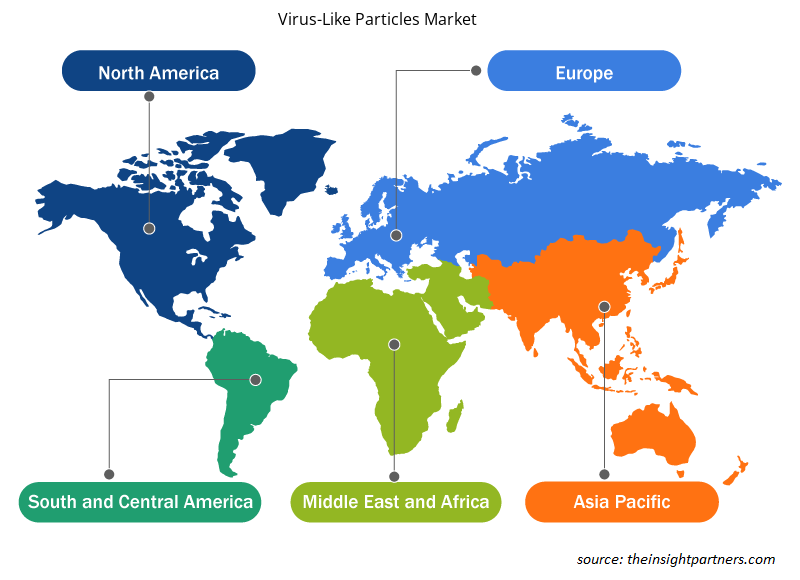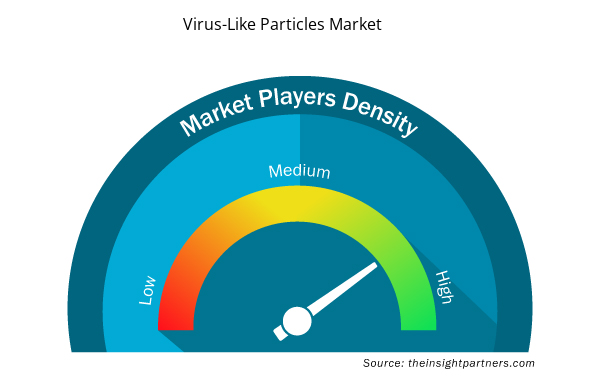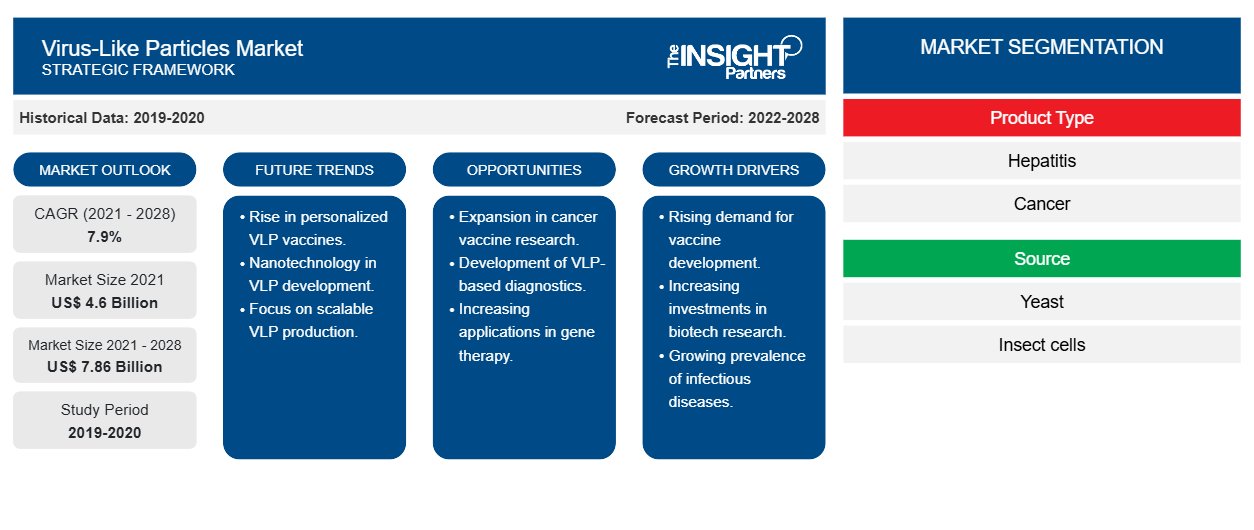ウイルス様粒子(VLP)市場は、2021年の46億184万米ドルから2028年には78億5882万米ドルに達すると予測されており、2021年から2028年にかけて7.9%のCAGRで成長すると予想されています。
ヒトおよび動物ウイルスに対するウイルス様粒子ベースのワクチンの商品化、ウイルス様粒子ベースのウイルスワクチン開発のための活発な研究開発活動、およびアレルギー疾患に対する信頼性の高い免疫療法プラットフォームとして浮上しているウイルス様粒子は、市場全体の成長を担う主要な原動力です。ただし、eVLPの設計、精製、および保管に関連する技術的な課題が、市場全体の成長を妨げています。さらに、ウイルス様粒子ワクチンの製造に関連する複雑さと、プロセス(ウイルス様粒子ベースのワクチンの下流処理など)の過剰なコストと時間要件が相まって、世界市場の成長がさらに制限されています。さらに、局所的および新興のウイルス性疾患や癌を対象としたウイルス様粒子ベースの治療薬はまだ開発中であり、市場全体の成長にとって有利な機会をもたらしています。
北米は、 2021年から2028年にかけて、ウイルス様粒子市場で優位を維持する可能性が高い。米国は北米で最大の市場シェアを占めており、予測期間中もこの傾向が続くと予想されます。これは主に、さまざまな変異体によって引き起こされるウイルス性インフルエンザなどのウイルス感染に対する人々の一般的な感受性に起因しています。さらに、生弱毒化ワクチンの製造に必要な継続的な研究開発活動により、バイオ医薬品企業はウイルス様粒子を選択せざるを得なくなり、これが市場の成長をさらに後押ししています。
要件に合わせてレポートをカスタマイズする
このレポートの一部、国レベルの分析、Excelデータパックなど、あらゆるレポートを無料でカスタマイズできます。また、スタートアップや大学向けのお得なオファーや割引もご利用いただけます。
- このレポートの主要な市場動向を入手してください。この無料サンプルには、市場動向から見積もりや予測に至るまでのデータ分析が含まれます。
市場分析
市販のウイルス様粒子ベースのワクチンが市場全体の成長を牽引
Frontiers Media SAが発表した報告書によると、最初のウイルス様粒子ベースのワクチンは、致死的なウイルスであるB型肝炎に対抗するために設計され、従来のワクチンと比較して、ウイルス様粒子ベースのワクチンは有望な安全性の結果を生み出しました。最初に市販されたウイルス様粒子ベースのワクチンは、HBVに対するものでした。また、市販の抗HBVワクチン、すなわちグラクソ・スミスクライン社製の「エンジェリックス」とメルク社製の「リコンビバックスHB」は1980年に承認されましたが、これらはすべてウイルス様粒子でした。次に市販されたウイルス様粒子ベースのワクチンは「ガーダシル」で、ヒトパピローマウイルス(HPV)感染の予防に2006年に承認されました。さらに、ウイルス様粒子は獣医学でも使用されています。ウイルス様粒子をベースにした最初の市販の獣医用ワクチンは、豚サーコウイルス2型(PCV2)に対する有効性が証明されました。
アレルギー疾患に対する免疫療法製品の開発におけるウイルス様粒子の役割は、市場全体の成長をさらに刺激します。ウイルス様粒子は、アレルギー性鼻炎、喘息、およびダニ反応の治療に使用されます。前述の要因により、ウイルス様粒子市場全体の成長が飛躍的に促進されます。ウイルス様粒子ワクチンは、副作用として軽度の皮膚反応を伴う迅速な免疫反応を示しています。
製品タイプに基づく洞察
製品タイプに基づいて、ウイルス様粒子市場は、肝炎、がん/ HPV、およびゴーシェ病に分類されます。肝炎セグメントは、2021〜2028年の間に大きな市場シェアを占めると予想されます。Frontiers SAレポートは、C型肝炎ウイルス(HCV)が世界人口の2%に感染し、肝疾患と肝移植の主な原因であると指摘しています。この医学的脅威は、新しい抗ウイルス療法の導入によって部分的に対処できます。たとえば、リスクの高い静脈内薬物使用者をターゲットにした50〜80%の有効性を持つワクチンは、人口のHCV発生率を劇的に減らします。したがって、ウイルス様粒子は、適応免疫応答を誘発する安全で免疫原性が非常に高いワクチン送達プラットフォームを表します。現在、いくつかのウイルス様粒子ベースのワクチンが臨床試験中ですが、HBVおよびHPV用の認可されたVLPワクチンは長い間使用されてきました。このように、ウイルス様粒子ベースのワクチンは、好ましい免疫学的特性に関連してその有効性が証明されており、有望な HCV ワクチンの 1 つとなっています。
ソースベースの洞察
ウイルス様粒子(VLP)市場は、その発生源に基づいて、酵母、昆虫細胞、植物、その他に分類されます。酵母セグメントは相当な市場シェアを占めており、予測期間中も同様の傾向が続くと予測されています。ウイルス様粒子は、酵母やバキュロウイルス、植物、細菌などの異種発現システムによって生成されます。酵母発現システムを使用して生成されるウイルス様粒子ベースのワクチンの安全性は、酵母ベースのウイルス様粒子市場の成長に貢献しています。
アプリケーションベースの洞察
用途別に見ると、ウイルス様粒子市場はワクチンと治療薬に分類されます。ワクチン部門は2021年にかなりのシェアを占め、予測期間中も引き続き市場で優位に立つと見込まれます。ワクチン接種は、人間と動物の両方において、病原体を制御し病気を予防する最も効果的な方法の1つと考えられています。ウイルス様粒子ベースのワクチンは、その固有の免疫原性と安全性により、最も魅力的なアプローチの1つです。たとえば、ウイルス様粒子は非感染性の多量体抗原であり、粒子構造を持ち、安全で効率的な体液性および細胞性免疫応答の誘導に適しています。それとは別に、ウイルス様粒子ワクチンは獣医分野でその有効性が証明されています。ウイルス様粒子は、1つまたは複数の構造タンパク質のみで構成され、ネイティブウイルスのゲノムは存在せず、細胞内で自己複製する能力もありません。しかし、一価または多価の抗原を含むウイルス様粒子は、血清学的監視の要件に従って生成できるため、獣医学の分野ではウイルス様粒子ワクチンの有用性が期待できます。動物の病気に対するワクチン接種戦略として、感染動物とワクチン接種動物を区別する (DIVA) ワクチン接種戦略の下でウイルス様粒子ワクチンを使用する例の 1 つです。
ウイルス様粒子(VLP)市場で事業を展開する企業は、世界中で変化する顧客の需要を満たすために製品イノベーション戦略を採用しており、これにより世界市場で自社のブランド名を維持することも可能になっています。
ウイルス様粒子市場レポートの範囲
ウイルス様粒子市場の地域別分析
予測期間を通じてウイルス様粒子市場に影響を与える地域的な傾向と要因は、Insight Partners のアナリストによって徹底的に説明されています。このセクションでは、北米、ヨーロッパ、アジア太平洋、中東、アフリカ、南米、中米にわたるウイルス様粒子市場のセグメントと地理についても説明します。

- ウイルス様粒子市場の地域別データを入手
ウイルス様粒子市場レポートの範囲
| レポート属性 | 詳細 |
|---|---|
| 2021年の市場規模 | 46億米ドル |
| 2028年までの市場規模 | 78.6億米ドル |
| 世界のCAGR(2021年~2028年) | 7.9% |
| 履歴データ | 2019-2020 |
| 予測期間 | 2022-2028 |
| 対象セグメント | 製品タイプ別
|
| 対象地域と国 | 北米
|
| 市場リーダーと主要企業プロフィール |
|
市場プレーヤーの密度:ビジネスダイナミクスへの影響を理解する
ウイルス様粒子市場は、消費者の嗜好の変化、技術の進歩、製品の利点に対する認識の高まりなどの要因により、エンドユーザーの需要が高まり、急速に成長しています。需要が高まるにつれて、企業は提供を拡大し、消費者のニーズを満たすために革新し、新たなトレンドを活用し、市場の成長をさらに促進しています。
市場プレーヤー密度とは、特定の市場または業界内で活動している企業または会社の分布を指します。これは、特定の市場スペースに、その規模または総市場価値と比較して、どれだけの競合相手 (市場プレーヤー) が存在するかを示します。
ウイルス様粒子市場で事業を展開している主要企業は次のとおりです。
- メルク社
- グラクソ・スミスクライン
- ファイザー株式会社
- ダイナバックステクノロジーズ
- サノフィ
免責事項:上記の企業は、特定の順序でランク付けされていません。

- ウイルス様粒子市場のトップキープレーヤーの概要を入手
ウイルス様粒子(VLP)市場 – 製品タイプ別
- 肝炎
- がん/HPV
- ゴーシェ病
ウイルス様粒子(VLP)市場 – ソース別
- 酵母
- 昆虫細胞
- 植物
- その他
ウイルス様粒子(VLP)市場 – 用途別
- ワクチン
- 治療薬
ウイルス様粒子(VLP)市場 – 地域別
- 北米
- 私たち
- カナダ
- メキシコ
- ヨーロッパ
- フランス
- ドイツ
- イタリア
- 英国
- スペイン
- その他のヨーロッパ
- アジア太平洋(APAC)
- 中国
- インド
- 韓国
- 日本
- オーストラリア
- その他のアジア太平洋地域
- 中東およびアフリカ(MEA)
- 南アフリカ
- サウジアラビア
- アラブ首長国連邦
- MEAの残り
- 南米と中米(詐欺)
- ブラジル
- アルゼンチン
- 残りの詐欺
企業プロフィール
- メルク社
- グラクソ・スミスクライン
- ファイザー株式会社
- ダイナバックステクノロジーズ
- サノフィ
- ワンタイバイオファーム
- セラム インスティテュート オブ インディア株式会社
- バーラトバイオテック
- LG化学
- VBIワクチンズ株式会社
- 過去2年間の分析、基準年、CAGRによる予測(7年間)
- PEST分析とSWOT分析
- 市場規模価値/数量 - 世界、地域、国
- 業界と競争環境
- Excel データセット



Report Coverage
Revenue forecast, Company Analysis, Industry landscape, Growth factors, and Trends

Segment Covered
This text is related
to segments covered.

Regional Scope
North America, Europe, Asia Pacific, Middle East & Africa, South & Central America

Country Scope
This text is related
to country scope.
よくある質問
American Society for Microbiology defines virus-like particles (VLP's) as non-infectious multiprotein structure that are engineered to self-assemble from viral structure proteins. VLP technology proves to be a very powerful tool involved in development of vaccines. Several VLP based vaccines exist in the global market involving hepatitis B virus and human papillomavirus.
Commercial VLP based vaccines against human and animal viruses, intensive research and development activities for the development of VLPs based vaccines effective against viral infections, and VLPs acting as the best immunotherapy platform for allergic diseases are the key driving factors responsible for the overall market growth.
Based on product-type, hepatitis segment took the forefront lead in the worldwide market by accounting largest share in 2020 and is expected to continue to do so till the forecast period.
The vaccine segment dominated the global virus-like particles (VLP's) market and accounted for the largest revenue of 4,558.08 Mn in 2021.
Answer: - Merck & Co., Inc., GlaxoSmithKline plc., Pfizer Inc., Dynavax Technologies, Sanofi, Wantai BioPharm, Serum Institute of India Pvt. Ltd., BHARAT BIOTECH, LG Chem, and VBI Vaccines Inc. are among the leading companies operating in the global Virus-Like Particles (VLP's) market
Global virus-like particles (VLP's) market is segmented by region into North America, Europe, Asia Pacific, Middle East & Africa, and South & Central America. In North America, the U.S. is the largest market for virus-like particles (VLP’s). The US is estimated to hold the largest share in the virus-like particles (VLP’s) market during the forecast period. Presence of top players and favorable regulations related to product approvals coupled with commercializing new products are the contributing factors for the regional growth. Additionally, increasing number of R&D activities is the key factor responsible for the Asia-Pacific regional growth for VLP’s accounting fastest growth of the region during the coming years.
Trends and growth analysis reports related to Life Sciences : READ MORE..
The List of Companies - Virus-like Particles (VLP's) Market
- Merck & Co., Inc.
- GlaxoSmithKline plc.
- Pfizer Inc.
- Dynavax Technologies
- Sanofi
- Wantai BioPharm
- Serum Institute of India Pvt. Ltd.
- BHARAT BIOTECH
- LG Chem
- VBI Vaccines Inc.
The Insight Partners performs research in 4 major stages: Data Collection & Secondary Research, Primary Research, Data Analysis and Data Triangulation & Final Review.
- Data Collection and Secondary Research:
As a market research and consulting firm operating from a decade, we have published and advised several client across the globe. First step for any study will start with an assessment of currently available data and insights from existing reports. Further, historical and current market information is collected from Investor Presentations, Annual Reports, SEC Filings, etc., and other information related to company’s performance and market positioning are gathered from Paid Databases (Factiva, Hoovers, and Reuters) and various other publications available in public domain.
Several associations trade associates, technical forums, institutes, societies and organization are accessed to gain technical as well as market related insights through their publications such as research papers, blogs and press releases related to the studies are referred to get cues about the market. Further, white papers, journals, magazines, and other news articles published in last 3 years are scrutinized and analyzed to understand the current market trends.
- Primary Research:
The primarily interview analysis comprise of data obtained from industry participants interview and answers to survey questions gathered by in-house primary team.
For primary research, interviews are conducted with industry experts/CEOs/Marketing Managers/VPs/Subject Matter Experts from both demand and supply side to get a 360-degree view of the market. The primary team conducts several interviews based on the complexity of the markets to understand the various market trends and dynamics which makes research more credible and precise.
A typical research interview fulfils the following functions:
- Provides first-hand information on the market size, market trends, growth trends, competitive landscape, and outlook
- Validates and strengthens in-house secondary research findings
- Develops the analysis team’s expertise and market understanding
Primary research involves email interactions and telephone interviews for each market, category, segment, and sub-segment across geographies. The participants who typically take part in such a process include, but are not limited to:
- Industry participants: VPs, business development managers, market intelligence managers and national sales managers
- Outside experts: Valuation experts, research analysts and key opinion leaders specializing in the electronics and semiconductor industry.
Below is the breakup of our primary respondents by company, designation, and region:

Once we receive the confirmation from primary research sources or primary respondents, we finalize the base year market estimation and forecast the data as per the macroeconomic and microeconomic factors assessed during data collection.
- Data Analysis:
Once data is validated through both secondary as well as primary respondents, we finalize the market estimations by hypothesis formulation and factor analysis at regional and country level.
- Macro-Economic Factor Analysis:
We analyse macroeconomic indicators such the gross domestic product (GDP), increase in the demand for goods and services across industries, technological advancement, regional economic growth, governmental policies, the influence of COVID-19, PEST analysis, and other aspects. This analysis aids in setting benchmarks for various nations/regions and approximating market splits. Additionally, the general trend of the aforementioned components aid in determining the market's development possibilities.
- Country Level Data:
Various factors that are especially aligned to the country are taken into account to determine the market size for a certain area and country, including the presence of vendors, such as headquarters and offices, the country's GDP, demand patterns, and industry growth. To comprehend the market dynamics for the nation, a number of growth variables, inhibitors, application areas, and current market trends are researched. The aforementioned elements aid in determining the country's overall market's growth potential.
- Company Profile:
The “Table of Contents” is formulated by listing and analyzing more than 25 - 30 companies operating in the market ecosystem across geographies. However, we profile only 10 companies as a standard practice in our syndicate reports. These 10 companies comprise leading, emerging, and regional players. Nonetheless, our analysis is not restricted to the 10 listed companies, we also analyze other companies present in the market to develop a holistic view and understand the prevailing trends. The “Company Profiles” section in the report covers key facts, business description, products & services, financial information, SWOT analysis, and key developments. The financial information presented is extracted from the annual reports and official documents of the publicly listed companies. Upon collecting the information for the sections of respective companies, we verify them via various primary sources and then compile the data in respective company profiles. The company level information helps us in deriving the base number as well as in forecasting the market size.
- Developing Base Number:
Aggregation of sales statistics (2020-2022) and macro-economic factor, and other secondary and primary research insights are utilized to arrive at base number and related market shares for 2022. The data gaps are identified in this step and relevant market data is analyzed, collected from paid primary interviews or databases. On finalizing the base year market size, forecasts are developed on the basis of macro-economic, industry and market growth factors and company level analysis.
- Data Triangulation and Final Review:
The market findings and base year market size calculations are validated from supply as well as demand side. Demand side validations are based on macro-economic factor analysis and benchmarks for respective regions and countries. In case of supply side validations, revenues of major companies are estimated (in case not available) based on industry benchmark, approximate number of employees, product portfolio, and primary interviews revenues are gathered. Further revenue from target product/service segment is assessed to avoid overshooting of market statistics. In case of heavy deviations between supply and demand side values, all thes steps are repeated to achieve synchronization.
We follow an iterative model, wherein we share our research findings with Subject Matter Experts (SME’s) and Key Opinion Leaders (KOLs) until consensus view of the market is not formulated – this model negates any drastic deviation in the opinions of experts. Only validated and universally acceptable research findings are quoted in our reports.
We have important check points that we use to validate our research findings – which we call – data triangulation, where we validate the information, we generate from secondary sources with primary interviews and then we re-validate with our internal data bases and Subject matter experts. This comprehensive model enables us to deliver high quality, reliable data in shortest possible time.


 このレポートの無料サンプルを入手する
このレポートの無料サンプルを入手する